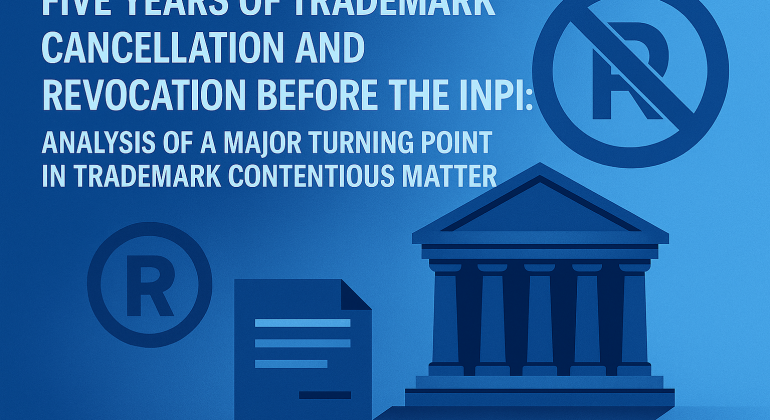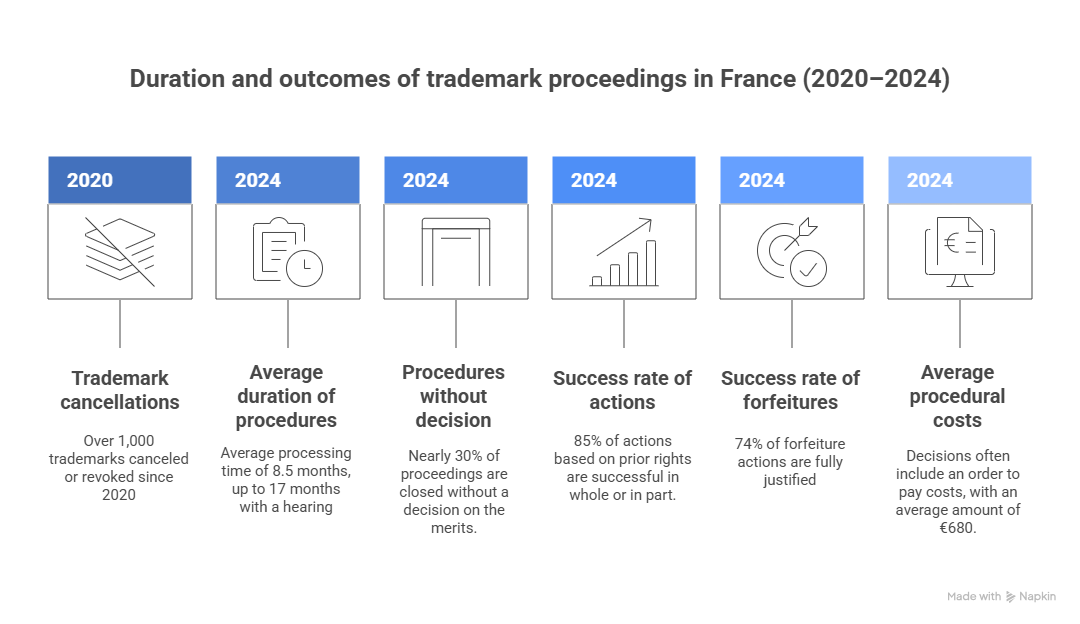Sommaire
Introduction
The publication by the INPI of its analysis of the first five years of cancellation and revocation procedures trademarks an important step in the evolution of trademark litigation in France. For the first time, the Office provides a comprehensive and documented overview of how these procedures, introduced by the Ordinance of November 13, 2019, and accessible since April 2020, actually work.
This report, published in the INPI’s Journal du droit, highlights how these administrative mechanisms have become a key tool in trade mark protection and litigation strategies. It outlines the profile of users, the legal grounds most frequently invoked, and the way the INPI applies the provisions of the Intellectual Property Code.
An administrative procedure that has become essential
Since their entry into force on April 1, 2020, applications for cancellation and revocation, provided for in Articles L. 714-3 and L. 714-5 of the Intellectual Property Code, have significantly transformed trademark litigation.
They offer several advantages:
- direct access, without going through a court;
- controlled costs, limiting the financial uncertainties of legal proceedings;
- decisions accessible in the INPI’s official legal database.
- a clear procedural framework, allowing for better anticipation.
The first decision issued in November 2020 confirmed the INPI’s ability to handle disputes previously reserved for specialized courts. Since then, companies, particularly SMEs, have actively used these procedures to protect their trademarks or challenge those of competitors.
A volume of decisions that is reshaping the landscape
In five years, the INPI has received approximately 2,200 applications and issued more than 1,800 decisions, a stable volume demonstrating widespread adoption by businesses and practitioners.
Breakdown of applications:
- 60% cancellation actions;
- 40% revocation actions.
These figures show two main uses:
- challenging the validity of a trademark upon filing
- sanctioning the absence of genuine use.
The analysis also highlights the strong involvement of SMEs and micro-enterprises, which represent more than one-third of applicants and defendants. The mechanism therefore achieves the accessibility objective set by the legislator.
The presence of a lawyer or patent attorney in over 90% of cases confirms that, despite its accessibility, the procedure remains legally demanding.
The legal grounds most commonly invoked the INPI
Relative grounds dominate cancellation actions :
Nearly 70% of cancellation requests are based on prior rights (Articles L. 711-3 et seq. of the CPI).
The INPI regularly recognizes the similarity or likelihood of confusion between signs, which explains the high success rate of this type of action.
Absolute grounds remain decisive :
Approximately 20% of actions invoke absolute grounds such as:
- lack of distinctiveness,
- descriptive character,
- violation of public policy,
- bad faith at the time of filing.
Bad faith, which was previously mainly examined by the courts, now plays an essential role before the INPI. It is invoked in more than 20% of cases and upheld in a significant proportion of them.
Revocation : lack of use as the main argument :
Lack of genuine use remains the main basis for revocation proceedings. The INPI notes that lack of commercial exploitation continues to be the easiest objective ground to document. Around 30 decisions also dealt with the degeneration or misleading nature of trademarks, which are rarer but important situations for certain sectors.
Duration, effectiveness, and observed trends
The average duration of proceedings is 8.5 months, which can extend to 17 months in the event of a hearing.
Nearly 30% of proceedings are closed without a decision on the merits (withdrawal, regularization, amicable agreement), which demonstrates the strategic use of proceedings as a bargaining chip.
Success rates are high:
- 85% of actions based on prior rights are successful in whole or in part;
- 74% of revocation actions are fully justified;
- More than 1,000 trademarks have been canceled or revoked since 2020.
Decisions often include an order to pay costs, with an average amount of €680, reinforcing the need for a solid strategy before initiating proceedings.
Practical issues for trademark owners
The publication of the analysis highlights several essential reflexes:
- regularly check the strength of registered trademarks;
- systematically keep evidence of use, which is essential in the event of a dispute;
- monitor competing filings to quickly detect conflicts using the tools provided by the INPI;
- factor the risk of cancellation into naming and branding decisions;
- prepare precise, documented, and structured arguments to maximize the chances of success.
To support these efforts, companies can rely on several useful resources:
- Journal de droit (analysis of decisions), INPI
- Légifrance for the applicable legal framework,
- The CNIL when evidence is based on online or time-stamped data.
Conclusion
The analysis published by the INPI confirms the key role played by cancellation and revocation proceedings in protecting trademarks in France. Their effectiveness, the diversity of the parties that use them, and their high success rate now make them an essential tool. For companies, the challenge is to adopt an active, proactive, and documented approach to managing their intellectual property in order to secure their intangible assets in the long term.
Dreyfus & Associés assists its clients in managing complex intellectual property cases, offering personalized advice and comprehensive operational support for the complete protection of intellectual property.
Nathalie Dreyfus with the support of the entire Dreyfus team
FAQ
1. What is the main benefit of the administrative procedure?
A quick, accessible, and effective resolution of trademark disputes.
2. What are the most effective grounds for cancellation?
Relative grounds based on prior rights.
3. How can genuine use of a trademark be proven?
With dated evidence: invoices, advertisements, sales statistics, web archives.
4. Can the INPI refuse to rule?
Yes, particularly in the event of a pre-existing legal dispute concerning the same facts.
5. Are actions for bad faith effective?
They are upheld in approximately half of the cases in which they are brought.


